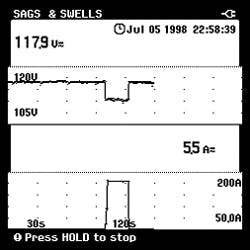Selecting the right power conditioning device can help keep your production running smoothly.
A small-engine plant located in the Tennessee Valley Authority (TVA) service territory continued to be plagued by frequent production equipment failures despite the installation of power conditioners. Another plant in the TVA system successfully solved its equipment failures in production and communications with power conditioners. Why such different results? At the engine plant, the problem was attributed to a slew of NEC Art. 250 violations — something no power conditioner could fix. At the other plant, the problem was simply big loads switching on and off. The plant resolved the issue by installing power conditioners between those loads and the problematic ones.
As we've seen, a power conditioner isn't able to handle infrastructure issues like bad grounding, but it can solve other problems like damaging transients. A 1994 study conducted by the National Power Laboratory (NPL) demonstrated the frequency of transients by recording voltage events on 120V receptacles at 112 sites for an aggregate of 32,225 days of monitoring. The average site experienced 289 voltage events per year. Nineteen were transients, 164 were moderate overvoltages (swells), 90 were sags, and 16 were interruptions.
Conditioner types and applications.
Some problems, like what plagued the small-engine plant described above, can't be fixed with power conditioning equipment. However, if you can benefit from installing power conditioners, you have several options to choose from.
Ferroresonant transformers.
These devices passively maintain a steady output voltage by operating in the transformer's saturation region, even when the input voltage fluctuates. Ferroresonants offer the advantage of converting any input waveform to a relatively true sine wave output (limited harmonics management). They can power loads through short outages — typically 1 cycle or less — due to the energy stored in their windings and capacitor. They protect against line noise because of their large physical isolation between primary and secondary windings. However, because they're bulky and inefficient, they're cost-effective only for small (<2 kVA) industrial applications.
Line filters.
The front ends of these devices employ MOVs to reduce voltage peaks. The actual filtering occurs in a circuit with a coil, resistors, and capacitors. These filters vary in complexity from passive line filters sized to the user's application, to active line filters that adjust a tank circuit based on conditions. Most UPS boxes today provide the functionality of a line filter, but with a battery backup.
Tap changing transformers.
When the primary problem is unstable line voltage, these devices, which automatically regulate the load voltage, can be effective. The electronic voltage regulators (EVRs) use a solid state switching mechanism to connect at different points on the winding and regulate the load voltage to less than ±1%. EVRs can adjust the steady state nominal output voltage to correct for any line drop issues. This approach is popular where large transient loads like motor loads, welding equipment, and elevators cause frequent swings in line voltage.
UPS systems.
These systems are the only protection against costly outages unless a facility has an alternate line source and transfer switch.
Offline UPSs are suitable for small applications (<1 kVA). They supply the load with utility power until it's out of tolerance (typically ±10% of nominal). Then, the UPS switches to its inverter, creating AC power from its battery bank. Offline systems offer limited protection against noise, surges, and harmonics, and don't regulate the output voltage.
Line interactive UPSs protect applications that demand constant voltage regulation and outage protection. Line interactive UPSs are similar to an offline UPS because they feed utility power directly to the load, but have the added ability to raise, or in some cases lower, the line voltage.
Double-conversion, true online UPSs use utility power to constantly charge its batteries, which supplies power to the inverter. The inverter regenerates 100% of the output power from scratch, eliminating line side power quality issues and providing tightly regulated, clean output power. Double-conversion UPSs offer true isolation from the utility system and provide full frequency regulation.
Generators.
You need a generator at higher demand levels (>30 kVA) and longer outage times. Sizing a battery for massive kVA or for outages longer than 30 min is rarely economical. Because of the start-up time required, a generator without a UPS will rarely be effective. Make sure the two are compatible before making the investment.
Remember, no single cure will solve all power quality problems. But once you identify your primary problem, you can develop the right strategy for solving it. If your infrastructure is correct, your strategy will include a power conditioner. You may solve your problem with a passive device or you may need something more complex, but if you've gathered the right data, your choices will be clear.
Katz is senior product manager at MGE, Costa Mesa, Calif. Pereles is an electrical marketing manager at Fluke, Everett, Wash.
